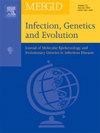2023年巴基斯坦流行性腮腺炎病毒G基因型的分子特征和遗传多样性
IF 2.6
4区 医学
Q3 INFECTIOUS DISEASES
引用次数: 0
摘要
腮腺炎尽管是一种疫苗可预防的疾病,但对全球公共卫生构成重大挑战。在巴基斯坦,由于国家免疫规划中没有腮腺炎疫苗接种,加上流行病学和监测数据有限,情况令人担忧。本研究调查了2023年流行性腮腺炎病毒(MuV)暴发期间的分子流行病学,重点研究了小疏水(SH)基因的遗传变异,这是病毒进化和基因分型的关键决定因素。在疫情期间,对腮腺肿大的疑似患者采集口腔拭子。62例腮腺炎疑似病例中,40例(64.5 %)通过RT-PCR检测MuV阳性。阳性病例在男性中的发病率(70 %)高于女性(30 %),其中在幼儿(0-5 岁)婴儿中发病率最高。系统发育分析结果显示,所有样本均为G基因型,与西班牙和日本、英国分离株G基因型同源性分别为97.4% %和98.73% %。这项研究强调了由于国家免疫规划中缺乏腮腺炎疫苗,巴基斯坦容易爆发腮腺炎,并强调了在该国建立有效的腮腺炎监测系统的必要性。本文章由计算机程序翻译,如有差异,请以英文原文为准。
Molecular characterization and genetic diversity of mumps virus genotype G in Pakistan during the 2023 outbreaks
Mumps, despite being a vaccine-preventable disease, poses a significant public health challenge globally. In Pakistan, the absence of mumps vaccination in the national immunization program, coupled with limited epidemiological and surveillance data, presents a concerning scenario. This study investigates the molecular epidemiology of the Mumps virus (MuV) during the 2023 outbreaks, focusing on the genetic variability of the small hydrophobic (SH) gene, a key determinant for viral evolution and genotyping. Buccal swabs were collected from suspected patients presenting swollen parotid glands during the outbreak periods. Out of 62 mumps suspects, 40 (64.5 %) samples tested positive for MuV through RT-PCR. The incidence rate of positive cases was higher in males (70 %) than in females (30 %), with the highest incidence observed in early childhood (0–5 year-old) infants. Phylogenetic analysis revealed that all the specimens belonged to genotype G, with 97.4 % homology with genotype G of MuV isolates from Spain and up to 98.73 % with Japan, and UK. This research study underscores Pakistan's vulnerability to mumps outbreaks due to the absence of mumps vaccine in the national immunization program and highlights the need for effective surveillance systems for Mumps in the country.
求助全文
通过发布文献求助,成功后即可免费获取论文全文。
去求助
来源期刊

Infection Genetics and Evolution
医学-传染病学
CiteScore
8.40
自引率
0.00%
发文量
215
审稿时长
82 days
期刊介绍:
(aka Journal of Molecular Epidemiology and Evolutionary Genetics of Infectious Diseases -- MEEGID)
Infectious diseases constitute one of the main challenges to medical science in the coming century. The impressive development of molecular megatechnologies and of bioinformatics have greatly increased our knowledge of the evolution, transmission and pathogenicity of infectious diseases. Research has shown that host susceptibility to many infectious diseases has a genetic basis. Furthermore, much is now known on the molecular epidemiology, evolution and virulence of pathogenic agents, as well as their resistance to drugs, vaccines, and antibiotics. Equally, research on the genetics of disease vectors has greatly improved our understanding of their systematics, has increased our capacity to identify target populations for control or intervention, and has provided detailed information on the mechanisms of insecticide resistance.
However, the genetics and evolutionary biology of hosts, pathogens and vectors have tended to develop as three separate fields of research. This artificial compartmentalisation is of concern due to our growing appreciation of the strong co-evolutionary interactions among hosts, pathogens and vectors.
Infection, Genetics and Evolution and its companion congress [MEEGID](http://www.meegidconference.com/) (for Molecular Epidemiology and Evolutionary Genetics of Infectious Diseases) are the main forum acting for the cross-fertilization between evolutionary science and biomedical research on infectious diseases.
Infection, Genetics and Evolution is the only journal that welcomes articles dealing with the genetics and evolutionary biology of hosts, pathogens and vectors, and coevolution processes among them in relation to infection and disease manifestation. All infectious models enter the scope of the journal, including pathogens of humans, animals and plants, either parasites, fungi, bacteria, viruses or prions. The journal welcomes articles dealing with genetics, population genetics, genomics, postgenomics, gene expression, evolutionary biology, population dynamics, mathematical modeling and bioinformatics. We also provide many author benefits, such as free PDFs, a liberal copyright policy, special discounts on Elsevier publications and much more. Please click here for more information on our author services .
 求助内容:
求助内容: 应助结果提醒方式:
应助结果提醒方式:


